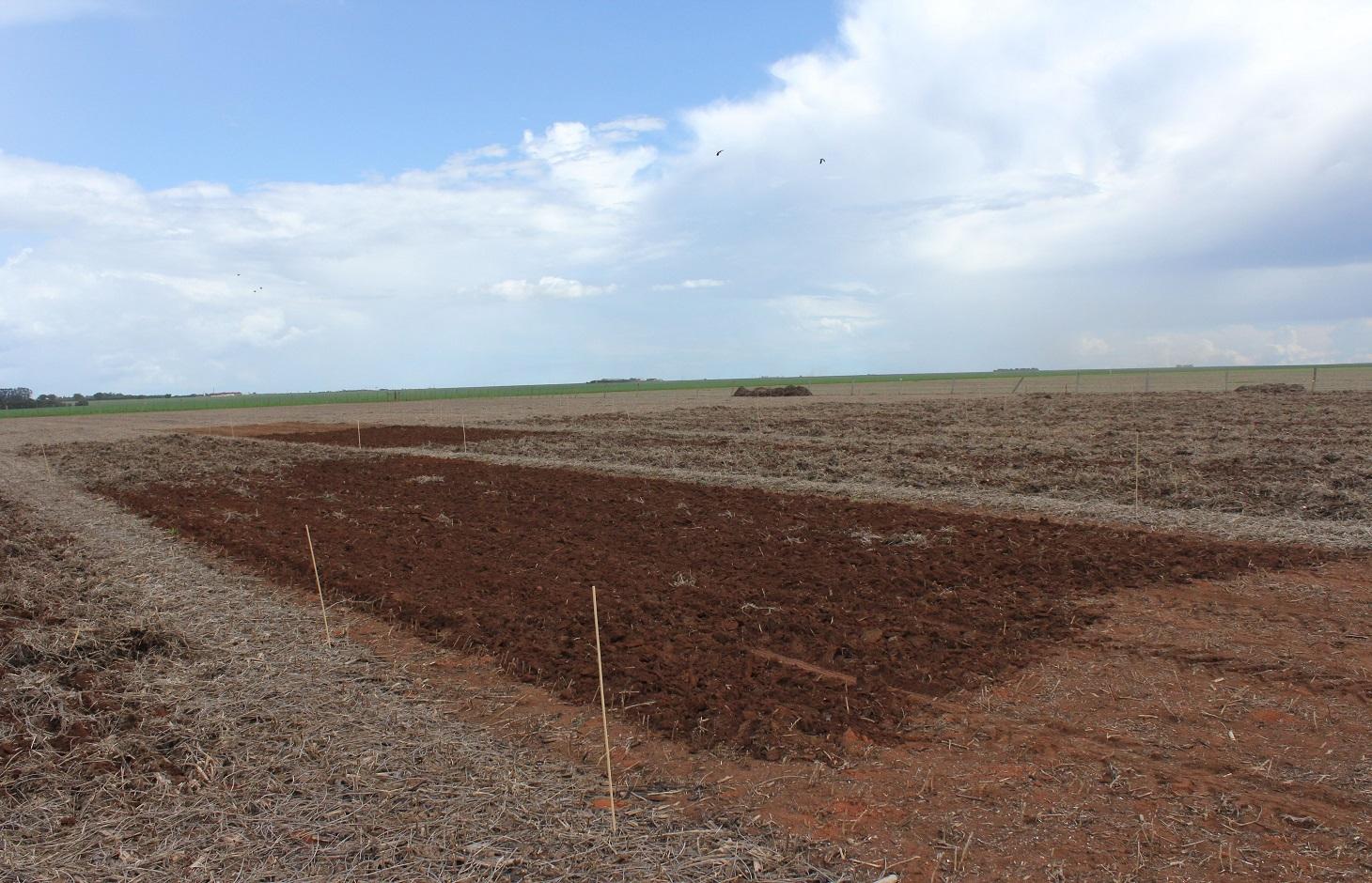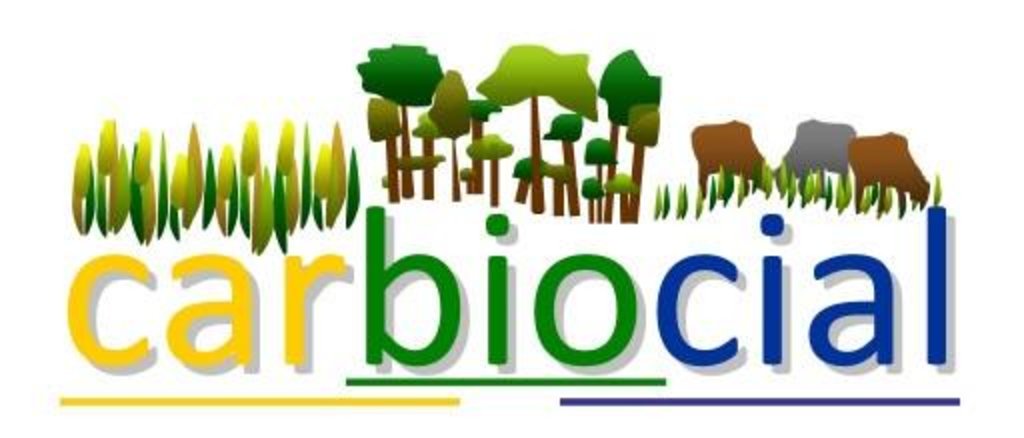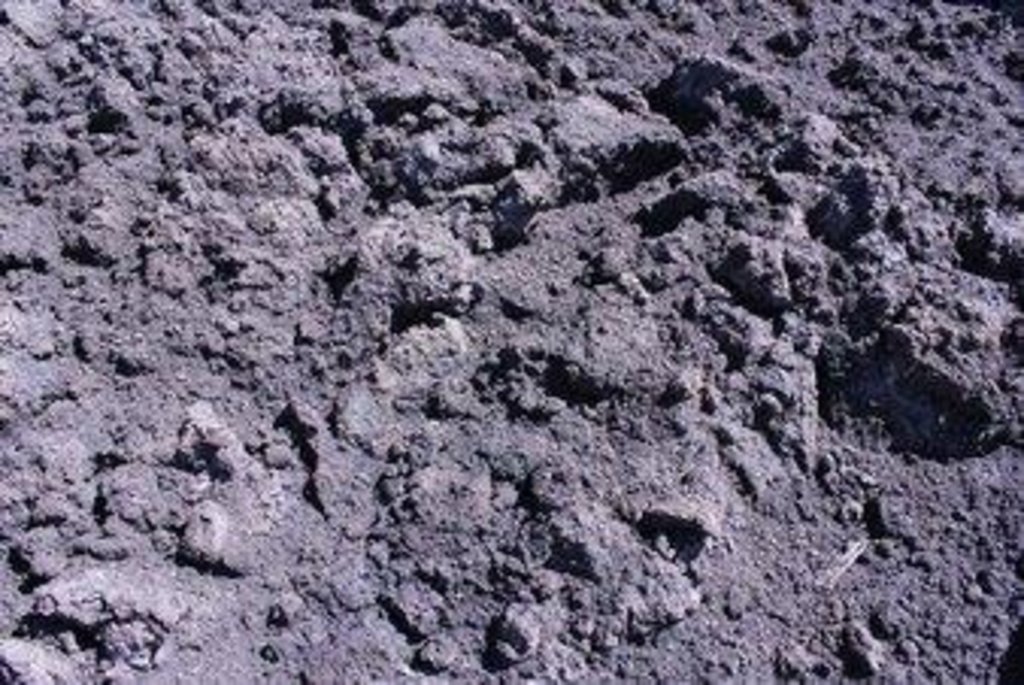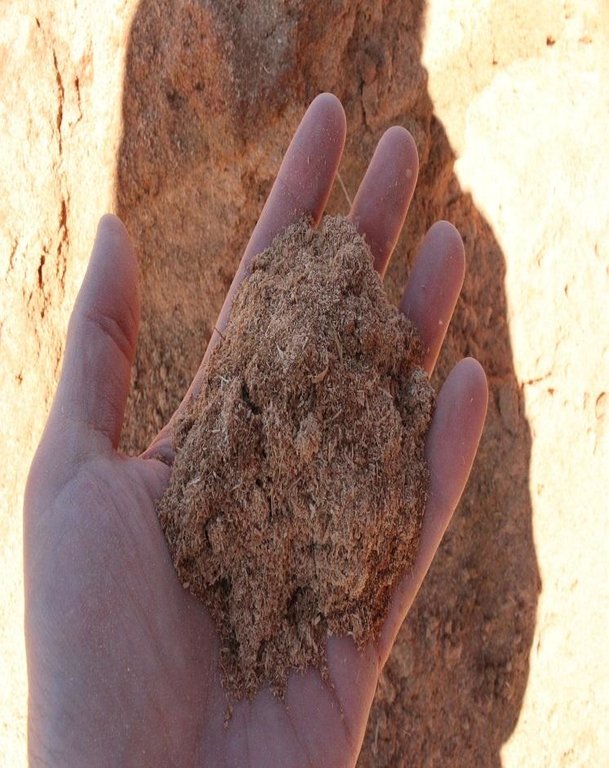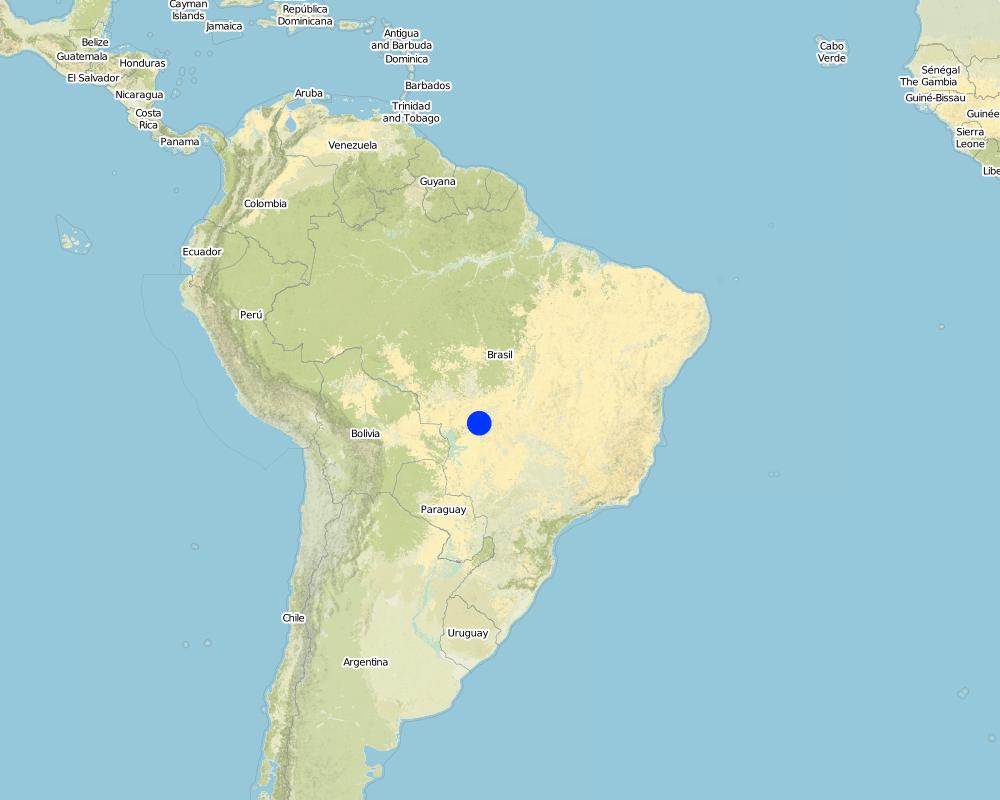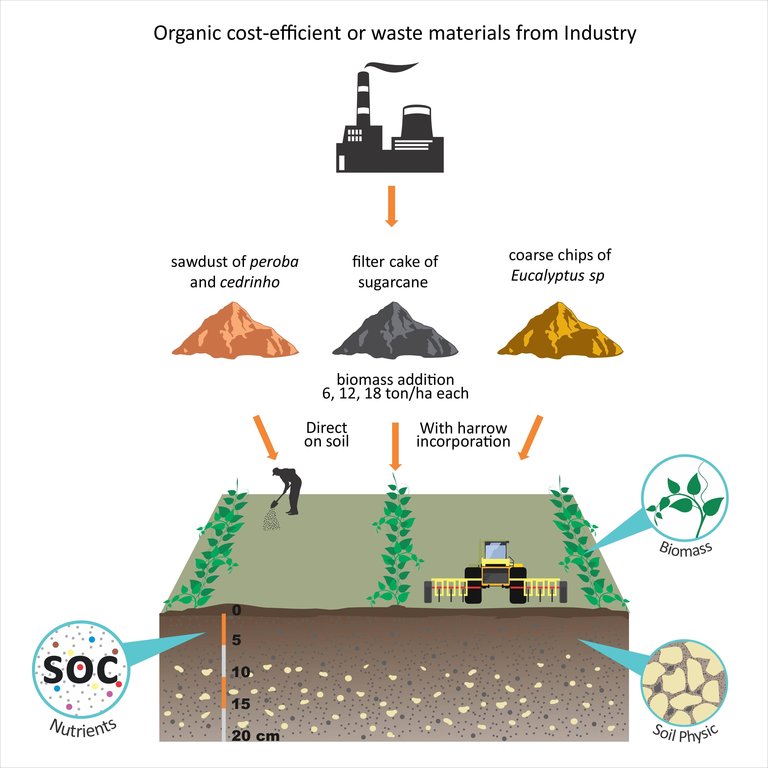Carbon-enrichment of tropical agricultural soil with organic matter [Brésil]
- Création :
- Mise à jour :
- Compilateur : Luisa F. Vega
- Rédacteur : –
- Examinateurs : Deborah Niggli, Alexandra Gavilano
Enriquecimento de carbono em solo de lavoura com matéria orgânica (Brazil)
technologies_1250 - Brésil
- Résumé complet en PDF
- Résumé complet en PDF pour impression
- Résumé complet dans le navigateur
- Résumé complet (non formaté)
- Carbon-enrichment of tropical agricultural soil with organic matter: 5 janvier 2017 (inactive)
- Carbon-enrichment of tropical agricultural soil with organic matter: 7 mars 2017 (inactive)
- Carbon-enrichment of tropical agricultural soil with organic matter: 29 avril 2017 (inactive)
- Carbon-enrichment of tropical agricultural soil with organic matter: 7 mars 2019 (public)
Voir les sections
Développer tout Réduire tout1. Informations générales
1.2 Coordonnées des personnes-ressources et des institutions impliquées dans l'évaluation et la documentation de la Technologie
Spécialiste GDT:
Irmler Prof. Dr. Ulrich
uirmler@ecology.uni-kiel.de
Institute for Ecosystem Research
Christian-Albrechts-Universität Kiel, 24118 Kiel, Germany
Allemagne
Spécialiste GDT:
Wantzen Prof. Dr. Karl M.
karl.wantzen@univ-tours.fr
CNRS UMR CITERES
University of Tours 37200 Tours, France www.karlmwantzen.de
France
Nom du projet qui a facilité la documentation/ l'évaluation de la Technologie (si pertinent)
Book project: Making sense of research for sustainable land management (GLUES)Nom du ou des institutions qui ont facilité la documentation/ l'évaluation de la Technologie (si pertinent)
University of Kiel (University of Kiel) - AllemagneNom du ou des institutions qui ont facilité la documentation/ l'évaluation de la Technologie (si pertinent)
Universidade Federal de Mato Grosso (Universidade Federal de Mato Grosso) - BrésilNom du ou des institutions qui ont facilité la documentation/ l'évaluation de la Technologie (si pertinent)
Université Francois-Rabelais de Tours (Université Francois-Rabelais de Tours) - France1.3 Conditions relatives à l'utilisation par WOCAT des données documentées
Le compilateur et la(les) personne(s) ressource(s) acceptent les conditions relatives à l'utilisation par WOCAT des données documentées:
Oui
1.4 Déclaration sur la durabilité de la Technologie décrite
Est-ce que la Technologie décrite ici pose problème par rapport à la dégradation des terres, de telle sorte qu'elle ne peut pas être déclarée comme étant une technologie de gestion durable des terres?
Non
2. Description de la Technologie de GDT
2.1 Courte description de la Technologie
Définition de la Technologie:
Carbon-enrichment of tropical agricultural soils with locally available organic matter in the Cerrado agricultural landscape, Brazil.
2.2 Description détaillée de la Technologie
Description:
In the Carbiocial Project viable land management strategies were explored to optimize the level of carbon in soil and water, helping to maintain and/or improve ecosystem functions, under changing climatic conditions in the Southern Amazon and the Brazilian Cerrado. In the framework of this project, on-farm experiments were performed to enrich tropical agricultural soils in the medium term, with different types of organic matter (OM). In the experiment the effect of different types of OM amendments on soil carbon and macro-nutrients (N, P, and K), soil physical properties (waterholding capacity) and crop yield (soy biomass and grain production) were assessed. The amendments applied are locally available, and are either free (being waste materials) or considered cost-efficient.
The objective of this on-going experiment is to compare the impact of (i) the quality and quantity of OM applied, (ii) and the application methods (directly on the soil surface or incorporation by harrow) on soil chemical and physical properties. It is hypothesised that the addition of OM can enhance crop yields and, potentially, soil biodiversity. The effects of the different OM types, amounts and application methods were evaluated after one, two and three years. From the results, the aim is to provide recommendations for the development of soil OM-enrichment schemes and carbon-friendly landscape management programs for farmers, using local resources.
The experiment was established on an area of about one hectare on a ferrasol (red latosol) at the Rio Engano Farm, in the municipality of Campo Verde, Mato Grosso State. The farm has a total area of ca. 1500 ha, 830 ha of which are cultivated with soybean and maize rotation, under a zero-tillage system, which is typical of many farms in this region. It is located in the Brazilian Cerrado (savanna) biome at about 685 m a.s.l. This biome covers 2 million km2, which is 23% of the country area. It has a semi-humid climate with a pronounced dry season. The precipitation during the rainy season (September-April) varies between 800 and 2000 mm/year.
At the beginning of the experiment (February 2012), three different types of OM amendments were applied. They comprised (a) sugarcane filter cake (Saccharum officinarum from ethanol/sugar-production, (b) sawdust of peroba and cedrinho (Peroba jaune and Erisma uncinatum, respectively) and (c) coarse chips of Eucalyptus sp. Quantities applied were 0 (control), 6, 12 and 18 tonnes of each per hectare; using two methods: directly on the soil surface, and incorporated by harrow. There were three repetitions per treatment. The area was not fenced to allow the farmers to continue with their field routines on all plots. In February 2013, 2014 and 2015 soil samples were taken to analyze their chemical and physical properties. Soybean samples were also taken in February 2014 and 2015 to estimate biomass and grain production. From the initial results some conclusions can be drawn: 1) Organic amendment addition to ferrasols can significantly increase soil organic carbon, even in amounts as low as 6 t/ha. 2) Amendments should be reapplied every 2 years. 3) The amendment type and application method does not have a significant effect on increasing soil organic carbon. 4) The addition of OM amendments is a win-win situation as a solution for organic matter waste recycling, and simultaneously to improve soil quality.
The area was not fenced to allow the farmer to continue with their arable field routines on all treatment plots. In February 2013, 2014 and 2015 soil samples were taken to analyze their chemical and physical properties. Soy bean samples were also taken in February 2014 and 2015 to estimate biomass and grain production.
From our first results we can draw some conclusions:
1) Organic amendment addition to Ferrasol can increase significantly soil organic carbon (SOC) percentage, even in small amounts such as 6 ton/ha.
2) Amendment reapplication should be done in 2 years intervals.
3) The amendment type and disposition did not have a significant effect on increasing SOC.
4) The addition of OM amendments is a win-win situation as a solution for organic matter waste recycling and to improve soil quality.
2.3 Photos de la Technologie
2.5 Pays/ région/ lieux où la Technologie a été appliquée et qui sont couverts par cette évaluation
Pays:
Brésil
Région/ Etat/ Province:
Mato Grosso
Autres spécifications du lieu:
Campo Verde
Map
×2.6 Date de mise en œuvre de la Technologie
Si l'année précise est inconnue, indiquez la date approximative: :
- il y a moins de 10 ans (récemment)
2.7 Introduction de la Technologie
Spécifiez comment la Technologie a été introduite: :
- au cours d'expérimentations / de recherches
- par le biais de projets/ d'interventions extérieures
Commentaires (type de projet, etc.) :
The enrichment of the soil by OM application is a traditional practice. Some of the added OM types in this experimet are already used in the Cerrado without any technical specification. This project aim to identify of one or more types, amounts and application methods of OM, which improve significantly soil quality and carbon stock. The OM effects are evaluated after 2 and 3 years of its addition, which was initially done in February 2012.
3. Classification de la Technologie de GDT
3.1 Principal(aux) objectif(s) de la Technologie
- améliorer la production
- préserver l'écosystème
3.2 Type(s) actuel(s) d'utilisation des terres, là où la Technologie est appliquée

Terres cultivées
- Cultures annuelles

Pâturages
Pâturage extensif:
- Ranching
Pâturage intensif/ production fourragère :
- Affouragement en vert/ zéro-pâturage
Commentaires:
Major land use problems (compiler’s opinion): Croplands demonstrate a reduction in soil organic matter, after their conversion from indigenous vegetation into agricultural fields. It is especially critical in the ferrasol soils of the Brazilian Cerrado, as its organic matter content is relatively low, and tropical temperatures and humidity accelerate microbial activity (Price and Sowers 2004)
Major land use problems (land users’ perception): There are also problems regarding soil compaction and rainfall regime change
Grazingland comments: There is some grazing by tapir, capibara, wild pig, ema, papagay
Type of grazing system comments: There is some grazing by tapir, capibara, wild pig, ema, papagay
3.3 Informations complémentaires sur l'utilisation des terres
Approvisionnement en eau des terres sur lesquelles est appliquée la Technologie:
- pluvial
Nombre de période de croissance par an: :
- 2
Précisez:
Longest growing period in days: 150, Longest growing period from month to month: November to March; Second longest growing period in days: 120, Second longest growing period from month to month: April to July
Densité d'élevage/ chargement (si pertinent):
> 100 LU /km2
3.4 Groupe de GDT auquel appartient la Technologie
- gestion intégrée de la fertilité des sols
3.5 Diffusion de la Technologie
Commentaires:
Total area covered by the SLM Technology is 0.011544 m2.
In the São Valentim Farm, located in the Brazilian Cerrado (savanna) biome. The experimental soil enrichment was established in February 2012, on a Ferrasol. The area was under a soybean-corn crop rotation
3.6 Mesures de GDT constituant la Technologie

pratiques agronomiques
- A2: Matière organique/ fertilité du sol
- A3: Traitement de la couche superficielle du sol
- A4: Traitement de la couche profonde du sol
Commentaires:
Type of agronomic measures: manure / compost / residues, zero tillage / no-till, non-inversion tillage
3.7 Principaux types de dégradation des terres traités par la Technologie

érosion hydrique des sols
- Wt: perte de la couche superficielle des sols (couche arable)/ érosion de surface

dégradation chimique des sols
- Cn: baisse de la fertilité des sols et réduction du niveau de matière organique (non causée par l’érosion)

dégradation physique des sols
- Pc: compaction

dégradation biologique
- Bs: baisse de la qualité et de la composition/ diversité des espèces
Commentaires:
Main causes of degradation: soil management (Extensive areas of monoculture), crop management (annual, perennial, tree/shrub) (Intensive soil use), deforestation / removal of natural vegetation (incl. forest fires) (In the region, the native vegetation of Cerrado was deforested during the early 80´s for agricultural purposes.), population pressure (Most of the agricultural production from The Brazilian Cerrado meet the food demand from Europe and China)
Secondary causes of degradation: Heavy / extreme rainfall (intensity/amounts) (There is an increase of extreme rainfall events which take place during the rainy season), labour availability (Reduction of availability of skilled labor for instance, to carry out integral monitoring of plagues), education, access to knowledge and support services (There a positive relationship between education level of farmers and the adoption of new technologies for sustainable land management), governance / institutional (Part of the colonization and conversion of the Brazilian Cerrado into agricultural systems was encouraged by Research (Embrapa) and Financing Government Programs)
3.8 Prévention, réduction de la dégradation ou réhabilitation des terres dégradées
Spécifiez l'objectif de la Technologie au regard de la dégradation des terres:
- réduire la dégradation des terres
4. Spécifications techniques, activités, intrants et coûts de mise en œuvre
4.1 Dessin technique de la Technologie
4.2 Spécification/ explications techniques du dessin technique
Enrichment of Tropical agricultural soil (Ferrasol) with organic matter amendments. Experimental design: amendment types, amounts and disposition methods (direct on the soil or with harrow incorporation). Studied variables: soil carbon and nutrients, soil physical properties (water holding capacity) and crop yield (soy biomass and grain production).
Location: Rio Engano Ranch. Campo Verde / Mato Grosso / Brazil
Date: 6.11.2015
Technical knowledge required for field staff / advisors: low
Technical knowledge required for land users: low
Main technical functions: increase in organic matter, increase / maintain water stored in soil
Secondary technical functions: control of raindrop splash, control of dispersed runoff: impede / retard, improvement of topsoil structure (compaction), stabilisation of soil (eg by tree roots against land slides), increase in nutrient availability (supply, recycling,…), increase of infiltration, increase of groundwater level / recharge of groundwater, water harvesting / increase water supply
Manure / compost / residues
Material/ species: (a) Filter cake of sugarcane residues (Saccharum officinarum from alcohol/sugar-production, (b) saw
Quantity/ density: 6, 12, 18
Zero tillage / no-till
Remarks: A part of the organic matter was added directly on the soil surface
Non-inversion tillage
Remarks: Another part of the organic matter was incorporate into the soil by using harrow
4.3 Informations générales sur le calcul des intrants et des coûts
autre/ monnaie nationale (précisez):
BRL
Indiquer le taux de change du dollars en monnaie locale (si pertinent): 1 USD= :
4,0
Indiquez le coût salarial moyen de la main d'œuvre par jour:
25.00
4.5 Coûts et intrants nécessaires à la mise en place
Commentaires:
Duration of establishment phase: 0 month(s)
4.6 Activités d'entretien/ récurrentes
| Activité | Type de mesures | Calendrier/ fréquence | |
|---|---|---|---|
| 1. | 1. Transport of amendments by trucks (0.2 tonne/US$) | Agronomique | |
| 2. | 2. Spreading / incorporation of organic matter by tractor (US$ 3/ha for petrol and US$ 5/ha for tractor driver). | Agronomique |
4.7 Coûts et intrants nécessaires aux activités d'entretien/ récurrentes (par an)
| Spécifiez les intrants | Unité | Quantité | Coûts par unité | Coût total par intrant | % des coût supporté par les exploitants des terres | |
|---|---|---|---|---|---|---|
| Main d'œuvre | labour | ha | 1,0 | 5,0 | 5,0 | 100,0 |
| Equipements | machine use | ha | 1,0 | 15,0 | 15,0 | 100,0 |
| Equipements | truck transport | ha | 1,0 | 150,0 | 150,0 | 100,0 |
| Coût total d'entretien de la Technologie | 170,0 | |||||
4.8 Facteurs les plus importants affectant les coûts
Décrivez les facteurs les plus importants affectant les coûts :
Amendment truck transport (0,2 ton/US$), amendment application by tractor(15 US$*ha/dia)
and tractor driver (5 US$*ha) costs.
The used organic matter amendments are cost-free. It is suggested to use cost-free materials if possible or cost–efficient materials to reduce implementation and maintenance costs. Transport of amendments is paid by tonne, independently of the type. The OM application methods (direct on the soil by hand or with harrow incorporation) did not show significant differences. For this reason only the costs for the tractor were calculated, because it is a more economic option.
5. Environnement naturel et humain
5.1 Climat
Précipitations annuelles
- < 250 mm
- 251-500 mm
- 501-750 mm
- 751-1000 mm
- 1001-1500 mm
- 1501-2000 mm
- 2001-3000 mm
- 3001-4000 mm
- > 4000 mm
Spécifications/ commentaires sur les précipitations:
The area presents strong seasonality: dry season (May-Sep) and rainy season (Oct-Apr)
Zone agro-climatique
- subhumide
Thermal climate class: tropics
5.2 Topographie
Pentes moyennes:
- plat (0-2 %)
- faible (3-5%)
- modéré (6-10%)
- onduleux (11-15%)
- vallonné (16-30%)
- raide (31-60%)
- très raide (>60%)
Reliefs:
- plateaux/ plaines
- crêtes
- flancs/ pentes de montagne
- flancs/ pentes de colline
- piémonts/ glacis (bas de pente)
- fonds de vallée/bas-fonds
Zones altitudinales:
- 0-100 m
- 101-500 m
- 501-1000 m
- 1001-1500 m
- 1501-2000 m
- 2001-2500 m
- 2501-3000 m
- 3001-4000 m
- > 4000 m
5.3 Sols
Profondeur moyenne du sol:
- très superficiel (0-20 cm)
- superficiel (21-50 cm)
- modérément profond (51-80 cm)
- profond (81-120 cm)
- très profond (>120 cm)
Texture du sol (de la couche arable):
- fin/ lourd (argile)
Matière organique de la couche arable:
- abondant (>3%)
5.4 Disponibilité et qualité de l'eau
Profondeur estimée de l’eau dans le sol:
5-50 m
Disponibilité de l’eau de surface:
bonne
Qualité de l’eau (non traitée):
uniquement pour usage agricole (irrigation)
5.5 Biodiversité
Diversité des espèces:
- faible
5.6 Caractéristiques des exploitants des terres appliquant la Technologie
Orientation du système de production:
- commercial/ de marché
Revenus hors exploitation:
- moins de 10% de tous les revenus
Niveau relatif de richesse:
- moyen
- riche
Individus ou groupes:
- individu/ ménage
Niveau de mécanisation:
- mécanisé/ motorisé
Genre:
- hommes
Indiquez toute autre caractéristique pertinente des exploitants des terres:
Land users applying the Technology are mainly common / average land users
Difference in the involvement of women and men: In the Cerrado most of the extensive crops (soy bean, corn and cotton) are managed by men
Population density: < 10 persons/km2
Annual population growth: > 4%; 7%
3% of the land users are very rich.
46% of the land users are rich.
51% of the land users are average wealthy.
Off-farm income specification: The off-farm income in the Cerrado is in most cases not relevant for farmers, both applying or not conservation meaures. Their income depent principally on agricultural activities such as soy bean, corn and cotton crops among others.
5.7 Superficie moyenne des terres détenues ou louées par les exploitants appliquant la Technologie
- < 0,5 ha
- 0,5-1 ha
- 1-2 ha
- 2-5 ha
- 5-15 ha
- 15-50 ha
- 50-100 ha
- 100-500 ha
- 500-1 000 ha
- 1 000-10 000 ha
- > 10 000 ha
Cette superficie est-elle considérée comme de petite, moyenne ou grande dimension (en se référant au contexte local)?
- petite dimension
5.8 Propriété foncière, droits d’utilisation des terres et de l'eau
Propriété foncière:
- individu, avec titre de propriété
Droits d’utilisation des terres:
- individuel
Droits d’utilisation de l’eau:
- loué
Commentaires:
The water used is regulated by the Environmental Secretary of the State (SEMA). Thus, water users have to obtain an Environmental License, where the volumen of water consumption is declared. The license is free of charge.
5.9 Accès aux services et aux infrastructures
santé:
- pauvre
- modéré
- bonne
éducation:
- pauvre
- modéré
- bonne
assistance technique:
- pauvre
- modéré
- bonne
emploi (par ex. hors exploitation):
- pauvre
- modéré
- bonne
marchés:
- pauvre
- modéré
- bonne
énergie:
- pauvre
- modéré
- bonne
routes et transports:
- pauvre
- modéré
- bonne
eau potable et assainissement:
- pauvre
- modéré
- bonne
services financiers:
- pauvre
- modéré
- bonne
6. Impacts et conclusions
6.1 Impacts sur site que la Technologie a montrés
Impacts socio-économiques
Production
production agricole
risque d'échec de la production
gestion des terres
Commentaires/ spécifiez:
There is not specific machinery for organic matter application in large scale
Disponibilité et qualité de l'eau
demande pour l'eau d'irrigation
Revenus et coûts
dépenses pour les intrants agricoles
revenus agricoles
Commentaires/ spécifiez:
In case the technology reduces the crop demand for chemical fertilization, nonetheless this effect has not been yet evaluated
Autres impacts socio-économiques
It provides a better environmental and technical use for agroindustrial residues
costs of transport and application of OM amendments
Impacts socioculturels
apaisement des conflits
Impacts écologiques
Sols
humidité du sol
cycle/ recharge des éléments nutritifs
matière organique du sol/ au dessous du sol C
Biodiversité: végétale, animale
biomasse/ au dessus du sol C
Autres impacts écologiques
increased soil micro-organisms and fauna
6.3 Exposition et sensibilité de la Technologie aux changements progressifs et aux évènements extrêmes/catastrophes liés au climat (telles que perçues par les exploitants des terres)
Changements climatiques progressifs
Changements climatiques progressifs
| Saison | Type de changements/ extrêmes climatiques | Comment la Technologie fait-elle face à cela? | |
|---|---|---|---|
| températures annuelles | augmente | pas bien |
Extrêmes climatiques (catastrophes)
Catastrophes météorologiques
| Comment la Technologie fait-elle face à cela? | |
|---|---|
| pluie torrentielle locale | bien |
| tempête de vent locale | bien |
Catastrophes climatiques
| Comment la Technologie fait-elle face à cela? | |
|---|---|
| sécheresse | pas bien |
Catastrophes hydrologiques
| Comment la Technologie fait-elle face à cela? | |
|---|---|
| inondation générale (rivière) | pas bien |
Autres conséquences liées au climat
Autres conséquences liées au climat
| Comment la Technologie fait-elle face à cela? | |
|---|---|
| réduction de la période de croissance | pas bien |
6.4 Analyse coûts-bénéfices
Quels sont les bénéfices comparativement aux coûts de mise en place (du point de vue des exploitants des terres)?
Rentabilité à court terme:
légèrement négative
Rentabilité à long terme:
positive
Quels sont les bénéfices comparativement aux coûts d'entretien récurrents (du point de vue des exploitants des terres)?
Rentabilité à court terme:
légèrement négative
Rentabilité à long terme:
positive
Commentaires:
The technology cost of maintenance is the same as establishment cost. According with our results, amendment reapplication should be done in 2 years intervals, starting from small amounts such as 6 ton/ha.
6.5 Adoption de la Technologie
Commentaires:
There is no trend towards spontaneous adoption of the Technology
Antonio Huebner, land owner and user of the Rio Engano Farm is aware of the technology benefits for soil fertility. However, he considers that OM costs of transport and application can hinder the technology incorporation into common practice for soil management.
6.7 Points forts/ avantages/ possibilités de la Technologie
| Points forts/ avantages/ possibilités du point de vue du compilateur ou d'une autre personne ressource clé |
|---|
| The addition of industrial organic matter (OM) waste from levels of only 6 tonnes/ha onwards can significantly increase soil organic carbon on a ferrasol in the Brazilian Cerrado. This increase took place regardless of the type of OM waste applied and even when the soil was under no-tillage for more than 20 years |
6.8 Faiblesses/ inconvénients/ risques de la Technologie et moyens de les surmonter
| Faiblesses/ inconvénients/ risques du point de vue de l’exploitant des terres | Comment peuvent-ils être surmontés? |
|---|---|
| The costs of transport and application can hinder the extensive use of soil OM enrichment practices among land users in the Brazilian Cerrado | Subsidies could encourage the technology adoption. |
| There is no specific machinery for OM spreading / incorporation, which increases human workload | To reduce human labour, it is recommended to design / adapt machinery for this purpose (e.g. of lime or mulch application machinery). However, more tests and improvements of the application methods are desirable. |
| Materials used as OM amendments could be toxic and pose a risk of soil pollution | It is important that land users are well informed about the risks. Crude forest material such as sawdust from peroba and cedrinho or roughly processed material such as filter cake of sugarcane used in this study should not have a toxic effect. Regarding the potential allelopathic effect of eucalyptus, its decomposing biomass does not seem to have a significant inhibitory effect on other crops (Chu et al. 2014) |
7. Références et liens
7.1 Méthodes/ sources d'information
- visites de terrain, enquêtes sur le terrain
- interviews/entretiens avec les exploitants des terres
7.2 Références des publications disponibles
Titre, auteur, année, ISBN:
Price PB, Sowers T (2004) Temperature dependence of metabolic rates for microbial growth, maintenance, and survival.
Disponible à partir d'où? Coût?
Proceedings of the National Academy of Sciences of the United States of America 101:4631-4636
Titre, auteur, année, ISBN:
Tivet F et al. (2013) Aggregate C depletion by plowing and its restoration by diverse biomass-C inputs under no-till in sub-tropical and tropical regions of Brazil.
Disponible à partir d'où? Coût?
Soil and tillage research, 126 :203-218
Titre, auteur, année, ISBN:
Zech W. et al. (1997) Factors controlling humific G. ation and Mineralization of soil organic matter in the tropics.
Disponible à partir d'où? Coût?
Geoderma 79 : 117-161
Titre, auteur, année, ISBN:
Chu, C. et al. (2014) Allelopathic effects of Eucalyptus on native and introduced tree species
Disponible à partir d'où? Coût?
Forest Ecology and Management, Volume 323: 79-84
Liens et modules
Développer tout Réduire toutLiens
Aucun lien
Modules
Aucun module trouvé


